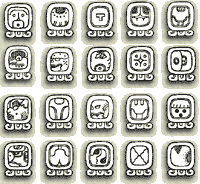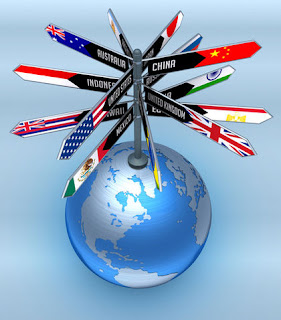Terence McKenna, and author and metaphysician, studied an ancient Chinese book I Ching (or Yi Jing) and concluded that history would reach a climax in 2012. It would be a time, during which, everything that can happen will happen. It was only later that he heard that the Maya Calendar had was resetting on the same date.
What is the Long Count?
The Long Count is really a mixed base-20/base-18 representation of a number, representing the number of days since the start of the Mayan era. It is thus akin to the Julian Day Number.
The basic unit is the kin (day), which is the last component of the Long Count. Going from right to left the remaining components are:
| uinal | (1 uinal = 20 kin = 20 days) |
| tun | (1 tun = 18 uinal = 360 days = approx. 1 year) |
| katun | (1 katun = 20 tun = 7,200 days = approx. 20 years) |
| baktun | (1 baktun = 20 katun = 144,000 days = approx. 394 years) |
| The kin, tun, and katun are numbered from 0 to 19. |
| The uinal are numbered from 0 to 17. |
| The baktun are numbered from 1 to 13. |
Although they are not part of the Long Count, the Mayas had names for larger time spans. The following names are sometimes quoted, although they are not ancient Maya terms:
| 1 pictun = 20 baktun = 2,880,000 days = approx. 7885 years |
| 1 calabtun = 20 pictun = 57,600,000 days = approx. 158,000 years |
| 1 kinchiltun = 20 calabtun = 1,152,000,000 days = approx. 3 million years |
| 1 alautun = 20 kinchiltun = 23,040,000,000 days = approx. 63 million years |
The alautun is probably the longest named period in any calendar.
When did the Long Count Start?
Logically, the first date in the Long Count should be 0.0.0.0.0, but as the baktun (the first component) are numbered from 1 to 13 rather than 0 to 12, this first date is actually written 13.0.0.0.0.
The authorities disagree on what 13.0.0.0.0 corresponds to in our calendar. I have come across three possible equivalences:
| 13.0.0.0.0 = 8 Sep 3114 BC (Julian) = 13 Aug 3114 BC (Gregorian) |
| 13.0.0.0.0 = 6 Sep 3114 BC (Julian) = 11 Aug 3114 BC (Gregorian) |
| 13.0.0.0.0 = 11 Nov 3374 BC (Julian) = 15 Oct 3374 BC (Gregorian) |
Assuming one of the first two equivalences, the Long Count will again reach 13.0.0.0.0 on 21 or 23 December AD 2012 - a not too distant future.
The date 13.0.0.0.0 may have been the Mayas’ idea of the date of the creation of the world.
What is the Tzolkin?
The Tzolkin date is a combination of two "week" lengths.
While our calendar uses a single week of seven days, the Mayan calendar used two different lengths of week:
- a numbered week of 13 days, in which the days were numbered from 1 to 13
- a named week of 20 days, in which the names of the days were:
| 0. Ahau | 1. Imix | 2. Ik | 3. Akbal | 4. Kan |
| 5. Chicchan | 6. Cimi | 7. Manik | 8. Lamat | 9. Muluc |
| 10. Oc | 11. Chuen | 12. Eb | 13. Ben | 14. Ix |
| 15. Men | 16. Cib | 17. Caban | 18. Etznab | 19. Caunac |
The diagram at left shows the day symbols, in the same order as the table above.
As the named week is 20 days and the smallest Long Count digit is 20 days, there is synchrony between the two; if, for example, the last digit of today’s Long Count is 0, today must be Ahau; if it is 6, it must be Cimi. Since the numbered and the named week were both "weeks," each of their name/number change daily; therefore, the day after 3 Cimi is not 4 Cimi, but 4 Manik, and the day after that, 5 Lamat. The next time Cimi rolls around, 20 days later, it will be 10 Cimi instead of 3 Cimi. The next 3 Cimi will not occur until 260 (or 13 x 20) days have passed. This 260-day cycle also had good-luck or bad-luck associations connected with each day, and for this reason, it became known as the "divinatory year."
The "years" of the Tzolkin calendar are not counted.
When did the Tzolkin Start?
Long Count 13.0.0.0.0 corresponds to 4 Ahau. The authorities agree on this.
What is the Haab?
The Haab was the civil calendar of the Mayas. It consisted of 18 "months" of 20 days each, followed by 5 extra days, known asUayeb. This gives a year length of 365 days.
The names of the month were:
| 1. Pop | 7. Yaxkin | 13. Mac |
| 2. Uo | 8. Mol | 14. Kankin |
| 3. Zip | 9. Chen | 15. Muan |
| 4. Zotz | 10. Yax | 16. Pax |
| 5. Tzec | 11. Zac | 17. Kayab |
| 6. Xul | 12. Ceh | 18. Cumku |
In contrast to the Tzolkin dates, the Haab month names changed every 20 days instead of daily; so the day after 4 Zotz would be 5 Zotz, followed by 6 Zotz ... up to 19 Zotz, which is followed by 0 Tzec.
The days of the month were numbered from 0 to 19. This use of a 0th day of the month in a civil calendar is unique to the Maya system; it is believed that the Mayas discovered the number zero, and the uses to which it could be put, centuries before it was discovered in Europe or Asia.
The Uayeb days acquired a very derogatory reputation for bad luck; known as "days without names" or "days without souls," and were observed as days of prayer and mourning. Fires were extinguished and the population refrained from eating hot food. Anyone born on those days was "doomed to a miserable life."
The years of the Haab calendar are not counted.
The length of the Tzolkin year was 260 days and the length of the Haab year was 365 days. The smallest number that can be divided evenly by 260 and 365 is 18,980, or 365×52; this was known as the Calendar Round. If a day is, for example, "4 Ahau 8 Cumku," the next day falling on "4 Ahau 8 Cumku" would be 18,980 days or about 52 years later. Among the Aztec, the end of a Calendar Round was a time of public panic as it was thought the world might be coming to an end. When the Pleaides crossed the horizon on 4 Ahau 8 Cumku, they knew the world had been granted another 52-year extension.
When did the Haab Start?
Long Count 13.0.0.0.0 corresponds to 8 Cumku. The authorities agree on this.
Did the Mayas Think a Year Was 365 Days?
Although there were only 365 days in the Haab year, the Mayas were aware that a year is slightly longer than 365 days, and in fact, many of the month-names are associated with the seasons; Yaxkin, for example, means "new or strong sun" and, at the beginning of the Long Count, 1 Yaxkin was the day after the winter solstice, when the sun starts to shine for a longer period of time and higher in the sky. When the Long Count was put into motion, it was started at 7.13.0.0.0, and 0 Yaxkin corresponded with Midwinter Day, as it did at 13.0.0.0.0 back in 3114 B.C.E. The available evidence indicates that the Mayas estimated that a 365-day year precessed through all the seasons twice in 7.13.0.0.0 or 1,101,600 days.
We can therefore derive a value for the Mayan estimate of the year by dividing 1,101,600 by 365, subtracting 2, and taking that number and dividing 1,101,600 by the result, which gives us an answer of 365.242036 days, which is slightly more accurate than the 365.2425 days of the Gregorian calendar.
(This apparent accuracy could, however, be a simple coincidence. The Mayas estimated that a 365-day year precessed through all the seasons twice in 7.13.0.0.0 days. These numbers are only accurate to 2-3 digits. Suppose the 7.13.0.0.0 days had corresponded to 2.001 cycles rather than 2 cycles of the 365-day year, would the Mayas have noticed?)
In ancient times, the Mayans had a tradition of a 360-day year. But by the 4th century B.C.E. they took a different approach than either Europeans or Asians. They maintained three different calendars at the same time. In one of them, they divided a 365-day year into eighteen 20-day months followed by a five-day period that was part of no month. The five-day period was considered to be unlucky.








 9:57 PM
9:57 PM
 SuperHRK
SuperHRK






















